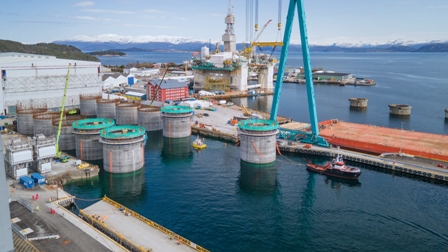
Aker Completes Phase 1 of the Hywind Tampen Construction
The first part of the construction of the Hywind Tampen concrete foundations was finalized this week at Aker Solutions’ yard in Stord, Norway. The 11 substructures are currently being towed to Vindafjord where the rest of the slip-forming and mechanical outfitting will be completed.
“Hywind Tampen is an important project for the transformation of the energy industry. We are happy to maintain progress in the midst of a pandemic and are now ready for the next phase of the project,” said Kenneth Simonsen, interim executive vice president and head of the renewables business in Aker Solutions.
Equinor’s Hywind Tampen is the world’s largest floating offshore windfarm and an important project for competency development and industrialization of offshore wind in Norway. The project is of great importance to secure access to electrical power offshore and reduce CO2 emissions from the Norwegian continental shelf. It is also a contribution to the positioning of the Norwegian industry for a growing international market.

“Aker Solutions’ goal is to contribute to low-carbon production on the Norwegian continental shelf and to be a part of the energy transition in the society. Our ambition is to grow our renewable projects and low-carbon solutions to count for one third of the revenues by 2025, and two thirds by 2030. To achieve this, projects such as Hywind Tampen are of great importance,” said Simonsen.
Aker Solutions’ contract with Equinor on Hywind Tampen includes construction of 11 floating concrete foundations for windmill turbines. The scope covers engineering, procurement and construction of the foundations, as well as marine operations.
The project has an estimated contract value of NOK 1.5 billion and will provide work for about 250 employees in Aker Solutions. Including ripple effects to subcontractors and the public sector, the project will involve around 800 work-years in total. The project has already resulted in several sub-contracts to Norwegian suppliers, particularly in the Rogaland and Vestland regions.
Information Source: Read Full Release ..–>
Press release


